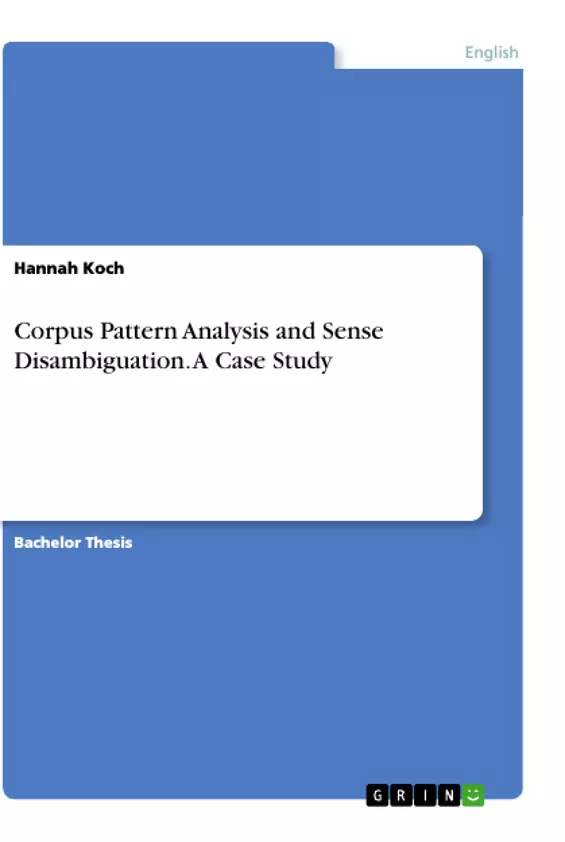The aim of the present paper is to figure out if and how the target words of this study, verbs derived from adjectives with the suffix –ify that were selected from the NOW Corpus, differ in use and show different meanings in context.
In order to analyse the target words to prettify and to vivify this paper will utilise of the technique promoted by Patrick Hanks. His theory of norms and exploitation (TNE) investigates meaning under the aspects of the mental lexicon and collocations. The target words will be analysed in the manner of Patrick Hanks Pattern Dictionary approach as well as the model of extended lexical units by John Sinclair in order to give an appropriate overview of the different aspects and nuances of their meaning.
Inhaltsverzeichnis (Table of Contents)
- Introduction
- Morphological Issues
- Suffixation
- The Suffix –ify
- Adjectives
- Suffixation
- Approaches to Lexical Analysis
- The Theory of Norms and Exploitation
- Pattern Dictionary of English Verbs
- Frame Semantics
- Word Sense disambiguation
- Valency
- Polysemy
- Collocation
- Colligation
- Semantic Preference
- Semantic Prosody
- The Theory of Norms and Exploitation
- Corpus Linguistics
- The British National Corpus
- The NOW Corpus
- Etymology and meaning
- Pretty
- Vivid
- Method and Analysis
- Analysis of to prettify
- Analysis of to vivify
- Conclusion
Zielsetzung und Themenschwerpunkte (Objectives and Key Themes)
This paper investigates the use and meaning of the verbs "to prettify" and "to vivify", derived from adjectives with the suffix "-ify", in the NOW Corpus. The research utilizes the "Theory of Norms and Exploitation" (TNE) by Patrick Hanks, examining the target words through the lens of his Pattern Dictionary approach and John Sinclair's model of extended lexical units. This analysis aims to provide a comprehensive understanding of the different aspects and nuances of their meanings.
- Morphological analysis of the suffix "-ify" and its impact on the target words
- Application of the Theory of Norms and Exploitation (TNE) to understand verb meaning
- Comparison of the Pattern Dictionary approach and the model of extended lexical units
- Analysis of the target words "to prettify" and "to vivify" in the NOW Corpus
- Exploration of the relationship between morphology, meaning, and corpus data
Zusammenfassung der Kapitel (Chapter Summaries)
The introduction outlines the study's objective: to examine the use and meaning of the verbs "to prettify" and "to vivify" in context. It introduces the methodology employed, drawing upon the "Theory of Norms and Exploitation" (TNE) by Patrick Hanks and his Pattern Dictionary approach. The second chapter explores morphological aspects, focusing on suffixation and the "-ify" suffix, as well as the characteristics of adjectives. The third chapter delves into theories of lexical analysis, including the TNE, Frame Semantics, valency, polysemy, and the model of extended lexical meaning. Chapter four offers a brief overview of corpus linguistics, highlighting the British National Corpus and the NOW Corpus. Chapter five provides the etymology and meaning of the target words "to prettify" and "to vivify". The final chapter will present the findings of the analysis, evaluating the results and offering a concluding outlook on the study's effectiveness and potential for further research.
Schlüsselwörter (Keywords)
The core focus of this paper lies in the analysis of the target words "to prettify" and "to vivify" in the context of the NOW Corpus. The study utilizes the Theory of Norms and Exploitation (TNE), Pattern Dictionary of English Verbs, Frame Semantics, valency, polysemy, collocation, colligation, semantic preference, and semantic prosody. These keywords encapsulate the research's main themes and methods.
- Quote paper
- Hannah Koch (Author), 2018, Corpus Pattern Analysis and Sense Disambiguation. A Case Study, Munich, GRIN Verlag, https://www.grin.com/document/1027140



